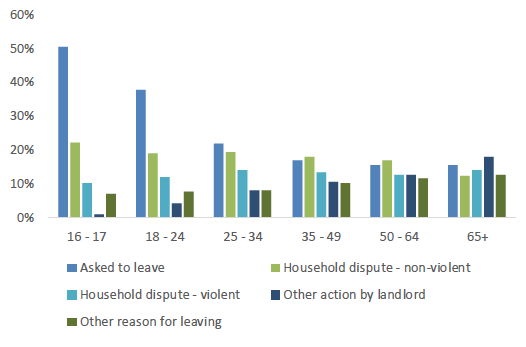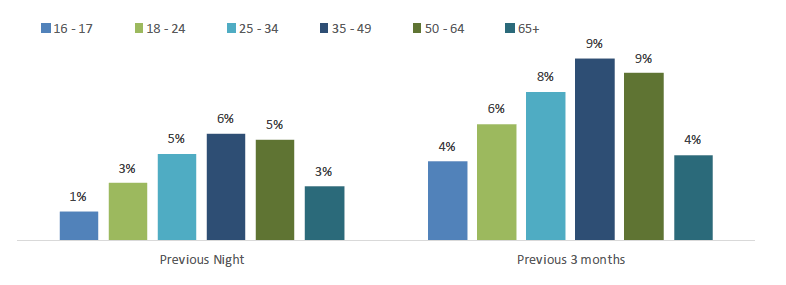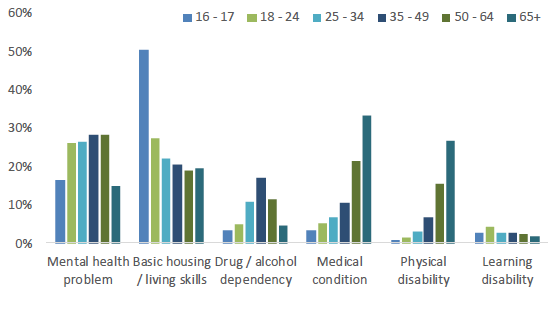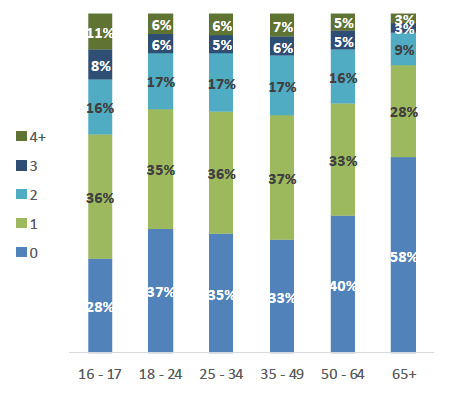Homelessness in Scotland: Equalities Breakdown 2019 to 2020
This bulletin provides information about homelessness in Scotland, with a focus on the equalities characteristics of homeless applicants.
This document is part of a collection
Age
The following provides key findings for aspects of homelessness where there are differences based on the age of the main applicant.
Reasons for homelessness and prior circumstances
Reasons for homelessness by age, percentages (2019/20)

The higher proportions of younger applicants giving a reason for homelessness as 'asked to leave' ties in with the higher proportion in these age groups citing 'lack of support from family' as additional reasons.
Also related, is that younger applicants are much more likely to report becoming homeless from 'parental / family home'.
Older applicants had a higher proportion stating ‘not to do with applicant household’ and ‘physical health reason’ as further reasons for failing to maintain accommodation, which are likely to be linked with the ‘other’ categories in the chart.
Older applicants are also more likely than other age groups to become homeless from a private rented property - 21% of those aged 50-64 and 25% age 65+ compared to 16% overall.
Those reporting rough sleeping by age, percentage (2019/20)

Older applicants were less likely to have previously been assessed as homeless in the previous 12 months - 3% of those aged 65 or over compared to 7% of 35-49 year olds, who were the most likely age group to be reassessed as homeless.[2]
Support needs
Support needs by age, percentage (2019/20)

Older applicants had a higher proportion stating 'not to do with applicant household' and 'physical health reason' as further reasons for failing to maintain accommodation, which are likely to be linked with the 'other' categories in the chart.
Older applicants are also more likely than other age groups to become homeless from a private rented property - 21% of those aged 50-64 and 25% age 65+ compared to 16% overall.
Temporary accommodation
Number of temporary accommodation placements by age, percentage (2019/20)

16-17 year olds had the highest number of placements and a greater proportion of placements in hostel accommodation than other age groups.
However, the average number of days spent in temporary accommodation for 16-17 year olds was lower than the overall average - 175 days vs 184.
Those aged 35-49 spent the longest time on average (200 days) in temporary accommodation.
Those aged 65+ spent the shortest on time average (133 days) in temporary accommodation.
25-49 year olds were most likely to not be offered temporary accommodation, accounting for 77% of the 4,595 instances recorded in 2019/20. Breaches of the unsuitable accommodation order were most common for this age group with 395 instances out of a total of 495.[3]
Outcomes
For most age categories, 82-84% secured settled accommodation upon case closure. The proportion of 16-17 year olds securing settled accommodation is lower at 68%, however, a larger proportion of applicants in this age group had an outcome of returning to previous accommodation or moved in with friends/relatives, which are not included within the definition of 'settled accommodation' used for these purposes.
It took longer for cases to complete for 16-17 year olds than any other age group – 269 days on average vs 224 days overall. In contrast, it took an average of 149 days for applicants aged 65+. These findings may be explained by the fact that 16-17 year olds have a higher take up of temporary accommodation than 65+ (72% vs 42%) and that for those aged 65+ who took it up spent, on average, less time in temporary accommodation compared to other age groups.
Contact
There is a problem
Thanks for your feedback